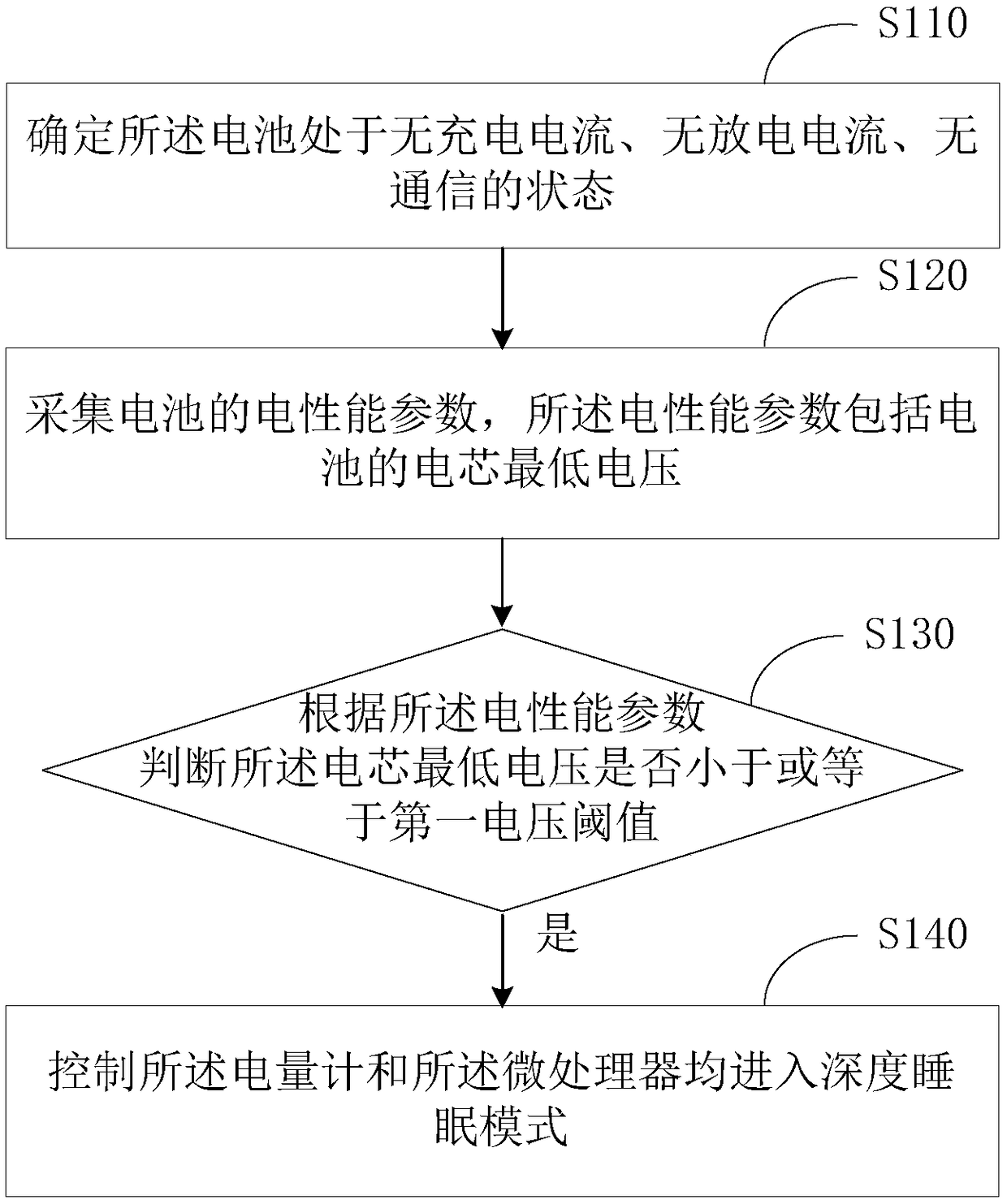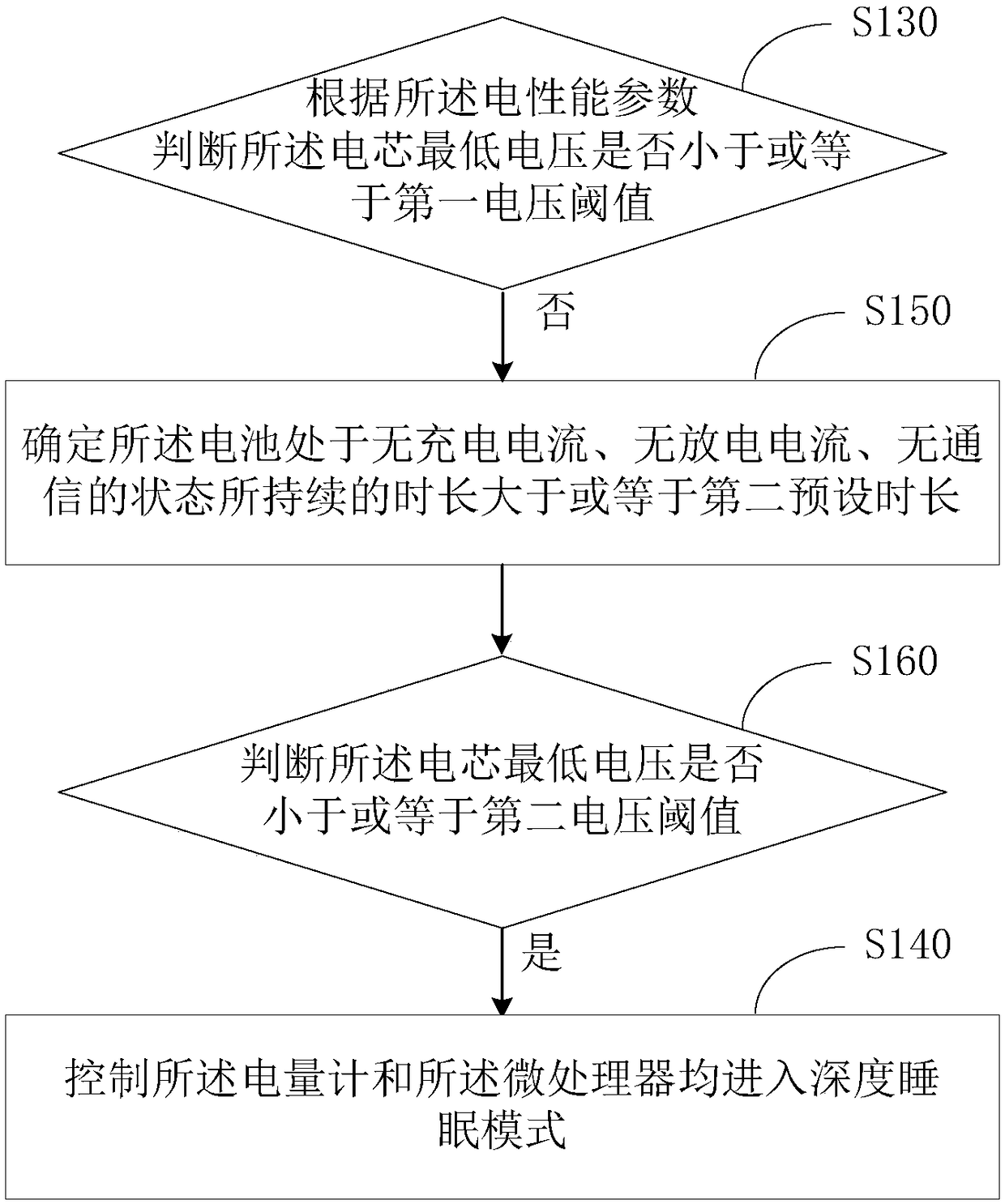Battery power consumption control method and device and unmanned aerial vehicle
A battery power consumption and control method technology, applied in the direction of program control, measuring device, computer control, etc., can solve the problem of high power consumption of the battery as a whole, achieve ultra-low power consumption, and protect the effect of over-discharge
- Summary
- Abstract
- Description
- Claims
- Application Information
AI Technical Summary
Problems solved by technology
Method used
Image
Examples
Embodiment 1
[0063] figure 2 It is a schematic flow chart of the battery power consumption control method provided by the embodiment of the present invention, combined with figure 1 The technical solution in the first embodiment will be described together. Such as figure 2 As shown, the battery power control method includes:
[0064] Step S110: Determine that the battery is in a state of no charging current, no discharging current, and no communication.
[0065] In one embodiment, considering that the battery is working normally (such as normal charging, normal discharge or normal communication), if the fuel gauge 20 is controlled to enter the deep sleep mode, it will cause serious consequences (such as when the UAV is flying). 20 Entering the deep sleep mode will cause the consequences of crashing), so it is necessary to make sure that the battery is in a state of no charging current, no discharging current, and no communication. The charging current or discharging current of the ba...
Embodiment 2
[0078] see image 3 , in one embodiment, when the judgment result of step S130 in the first embodiment above is no, it also includes:
[0079] Step S150: Determine that the duration of the battery being in a state of no charging current, no discharging current, and no communication is greater than or equal to a second preset duration.
[0080] In one embodiment, considering that the battery needs to better preserve the power of the battery pack 10 during transportation or long-term storage, the battery can be kept in a state of no charging current, no discharging current, and no communication. When it is determined that the battery is in the state of no charging current, no discharging current, and no communication for a duration greater than or equal to the second preset duration, we can consider that the battery is in the process of transportation or long-term storage .
[0081] The second preset duration can be artificially set as reasonable data, such as 3 days, 7 days, ...
Embodiment 3
[0088] see Figure 4 , in one embodiment, the electrical performance parameter in the above-mentioned embodiment 2 also includes the cell voltage difference, before step S140 also includes:
[0089] Step S170: According to the electrical performance parameters, it is determined that the cell voltage difference is smaller than a third voltage threshold.
[0090] In this embodiment, the cell voltage difference that appears refers to the absolute value of the voltage difference between any two cells in the cell set 10, that is, the absolute value of the voltage difference between any two cells is less than the third voltage Thresholds are considered to meet the conditions.
[0091] In one embodiment, the third voltage threshold is 30 millivolts. Normally, when the cell voltage difference in the battery pack 10 is greater than 30 millivolts, it means that the battery pack 10 needs to be balanced, otherwise it is not suitable to enter the normal working state again.
[0092] It ...
PUM
 Login to View More
Login to View More Abstract
Description
Claims
Application Information
 Login to View More
Login to View More - R&D
- Intellectual Property
- Life Sciences
- Materials
- Tech Scout
- Unparalleled Data Quality
- Higher Quality Content
- 60% Fewer Hallucinations
Browse by: Latest US Patents, China's latest patents, Technical Efficacy Thesaurus, Application Domain, Technology Topic, Popular Technical Reports.
© 2025 PatSnap. All rights reserved.Legal|Privacy policy|Modern Slavery Act Transparency Statement|Sitemap|About US| Contact US: help@patsnap.com



